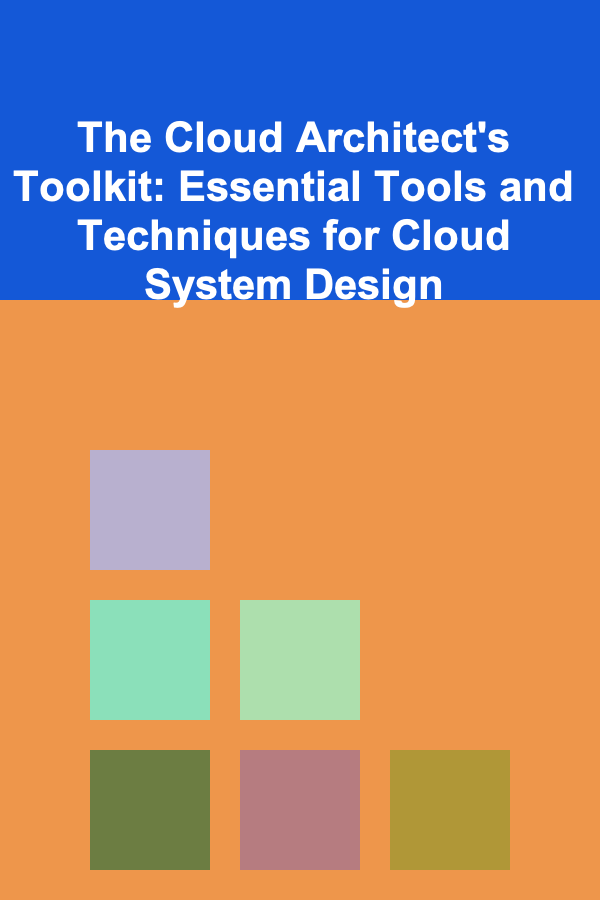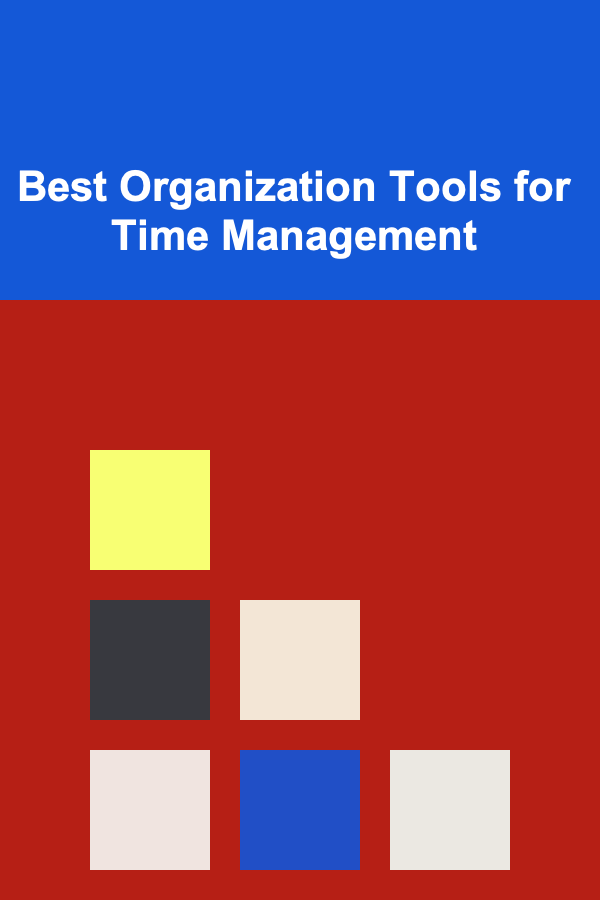
The Cloud Architect's Toolkit: Essential Tools and Techniques for Cloud System Design
ebook include PDF & Audio bundle (Micro Guide)
$12.99$10.99
Limited Time Offer! Order within the next:

Cloud computing has become a cornerstone of modern IT infrastructure, providing businesses with the flexibility to scale, innovate, and remain competitive in an ever-evolving technological landscape. As cloud adoption continues to grow, the role of the cloud architect has become more critical than ever before. A cloud architect is responsible for designing, implementing, and managing cloud-based systems and applications that meet both technical and business requirements.
To excel in this role, cloud architects need a diverse set of tools and techniques that can help them navigate the complexities of cloud system design. In this guide, we will explore the essential tools and techniques that every cloud architect should have in their toolkit. Whether you're designing cloud-native applications or migrating legacy systems to the cloud, this guide will provide actionable insights for optimizing cloud architectures.
Key Principles of Cloud System Design
Before diving into the tools and techniques, it's essential to understand the key principles of cloud system design. These principles serve as the foundation upon which cloud architectures are built.
1. Scalability
One of the core benefits of the cloud is its ability to scale resources up or down based on demand. A well-designed cloud system should be able to handle varying workloads efficiently, whether it's high traffic during peak periods or minimal traffic during off-peak times.
2. Reliability and Availability
Cloud systems must be designed to be highly reliable, with minimal downtime and the ability to recover quickly from failures. High availability architectures often leverage redundant resources and fault tolerance mechanisms to ensure that services remain operational even when individual components fail.
3. Security
Security is paramount in cloud system design. Cloud architects need to design systems that safeguard sensitive data, manage access controls, and ensure compliance with relevant regulations. Secure cloud systems often involve the use of encryption, identity and access management (IAM), and continuous monitoring.
4. Cost Optimization
Cloud services can be highly cost-effective, but only if they're designed with cost optimization in mind. A well-architected system ensures that resources are used efficiently, minimizing waste and over-provisioning while still meeting performance requirements.
5. Automation and Infrastructure as Code (IaC)
Automation plays a key role in cloud system design, allowing for the deployment, management, and scaling of cloud resources without manual intervention. Infrastructure as Code (IaC) enables architects to define and manage cloud resources using code, making it easier to automate and version control the infrastructure.
Essential Tools for Cloud Architects
1. Cloud Provider Platforms
Every cloud architect needs to be well-versed in the major cloud service providers (CSPs), such as:
- Amazon Web Services (AWS)
- Microsoft Azure
- Google Cloud Platform (GCP)
Each of these platforms offers a wide range of services for compute, storage, networking, security, and monitoring, and understanding how to leverage these services effectively is a foundational skill for cloud architects. These platforms often provide design patterns, templates, and architecture guidelines that can be invaluable when creating complex cloud systems.
- AWS Architecture Center: Provides well-architected frameworks, reference architectures, and best practices.
- Azure Architecture Center: Offers cloud design patterns, operational considerations, and guidance on Azure-based solutions.
- Google Cloud Architecture Framework: Provides a set of principles and best practices for designing and deploying applications on Google Cloud.
2. Infrastructure as Code (IaC) Tools
Infrastructure as Code (IaC) is a critical practice for cloud architects, as it allows for consistent and repeatable cloud infrastructure deployments. Several tools are widely used to implement IaC:
- Terraform: A popular IaC tool that enables the provisioning and management of cloud resources using a declarative configuration language. Terraform is platform-agnostic and can manage resources across AWS, Azure, GCP, and other platforms.
- AWS CloudFormation: AWS's native IaC tool that allows architects to define AWS resources using JSON or YAML templates.
- Azure Resource Manager (ARM) Templates: Azure's IaC tool for deploying and managing cloud resources with JSON templates.
- Pulumi: An IaC tool that enables cloud infrastructure management using familiar programming languages like TypeScript, Python, and Go.
These tools help automate the provisioning of cloud resources, ensuring that environments are consistently and securely deployed.
3. Containerization and Orchestration Tools
Containers and microservices are central to modern cloud application architectures, and cloud architects need to be proficient in containerization and orchestration tools. These tools help ensure that applications can be packaged, deployed, and managed efficiently across cloud environments.
- Docker: A tool that allows for the creation and management of lightweight, portable containers for applications.
- Kubernetes: An open-source orchestration platform for automating the deployment, scaling, and management of containerized applications. Kubernetes is widely used in cloud-native architectures for its ability to manage distributed applications in a cloud environment.
- Helm: A package manager for Kubernetes that simplifies the process of deploying and managing applications on Kubernetes clusters.
- Docker Compose: A tool for defining and running multi-container Docker applications. It is commonly used for testing and developing cloud applications in local environments before scaling to production.
By leveraging these tools, cloud architects can create flexible, scalable, and easily deployable application architectures in the cloud.
4. Monitoring and Observability Tools
To ensure that cloud systems are running smoothly and efficiently, cloud architects need to implement robust monitoring and observability practices. These tools provide insights into the health, performance, and security of cloud systems, enabling proactive issue resolution and optimization.
- Prometheus: An open-source monitoring system and time-series database designed for containerized environments. It is often used in conjunction with Kubernetes to collect metrics and alert based on performance thresholds.
- Grafana: A visualization tool often used with Prometheus to create dashboards and visual representations of system metrics.
- Datadog: A cloud monitoring platform that provides visibility into infrastructure, applications, and logs. Datadog integrates with multiple cloud providers and services.
- AWS CloudWatch: AWS's native monitoring service that collects and tracks metrics, logs, and events from AWS resources and applications.
- Azure Monitor: A comprehensive solution for monitoring the performance and health of applications and infrastructure in Azure.
Monitoring tools help cloud architects track the performance of their systems and ensure that they meet the required availability and reliability standards.
5. Security and Compliance Tools
Security is a top priority for cloud architects, and there are several tools that can assist in ensuring that cloud systems are designed securely and in compliance with regulatory requirements.
- AWS Identity and Access Management (IAM): AWS's native tool for controlling access to resources based on user roles and policies.
- Azure Active Directory (AAD): A cloud-based identity and access management service that provides authentication and authorization across Azure services.
- Google Cloud IAM: Google Cloud's service for defining access permissions for users and resources within the platform.
- HashiCorp Vault: An open-source tool for secrets management that helps securely store and access sensitive data such as API keys and passwords.
- Cloud Security Posture Management (CSPM): Tools such as Prisma Cloud by Palo Alto Networks or AWS Security Hub help monitor the security configurations of cloud resources and ensure compliance with industry standards.
These tools assist cloud architects in building secure cloud systems by enforcing the principle of least privilege, managing credentials, and ensuring that data is encrypted both in transit and at rest.
Best Practices for Cloud System Design
While the tools are essential, the techniques you apply in designing cloud systems play a critical role in ensuring that the architecture is optimal, scalable, and secure. Here are some best practices that cloud architects should follow:
1. Design for Failure
In the cloud, failures are inevitable. Design your systems with redundancy and fault tolerance in mind to ensure that a failure in one part of the system doesn't lead to a complete outage. Use multiple availability zones, load balancers, and backup systems to build resilient architectures.
2. Leverage Managed Services
Cloud providers offer a variety of managed services that handle the complexity of infrastructure management. Whenever possible, use these services instead of building custom solutions. Managed services like AWS RDS (Relational Database Service) or Azure App Services reduce the operational burden on your team, allowing you to focus on higher-level business logic.
3. Automate Everything
Automation is key to maintaining consistency and reducing human error. From provisioning infrastructure to application deployment, ensure that as much of your process as possible is automated. Tools like Terraform, Ansible, and CI/CD pipelines can help automate these tasks.
4. Adopt a Microservices Architecture
Microservices enable flexibility, scalability, and faster development cycles. Breaking down applications into smaller, independently deployable services allows teams to work autonomously while maintaining a flexible and scalable system.
5. Continuous Optimization
Cloud systems are dynamic, and ongoing optimization is necessary to ensure that resources are used efficiently and cost-effectively. Regularly review cloud usage patterns and adjust resource allocations to minimize waste. Tools like AWS Trusted Advisor and Azure Cost Management can provide insights into cost-saving opportunities.
Conclusion
Cloud system design is a complex process that requires a deep understanding of both the tools and the best practices that ensure the delivery of high-performance, scalable, and secure solutions. By leveraging the right tools---from cloud provider platforms to IaC and container orchestration tools---and following best practices for reliability, security, and automation, cloud architects can create robust cloud systems that meet both technical and business requirements.
Mastering the cloud architect's toolkit is an ongoing process, as cloud technologies continue to evolve. Staying current with new tools, practices, and cloud innovations will ensure that cloud architects remain at the forefront of this transformative field.

Best Organization Tools for Time Management
Read More
How to Implement a Regular Garage Maintenance Routine
Read More
How to Improve Your Home's Curb Appeal with Regular Maintenance
Read More
How to Leverage Home Staging to Increase Property Value
Read More
How to Make a Checklist for Creating a Self-Care Sanctuary at Home
Read More
How To Practice Thoughtful Gestures of Love
Read MoreOther Products

Best Organization Tools for Time Management
Read More
How to Implement a Regular Garage Maintenance Routine
Read More
How to Improve Your Home's Curb Appeal with Regular Maintenance
Read More
How to Leverage Home Staging to Increase Property Value
Read More
How to Make a Checklist for Creating a Self-Care Sanctuary at Home
Read More